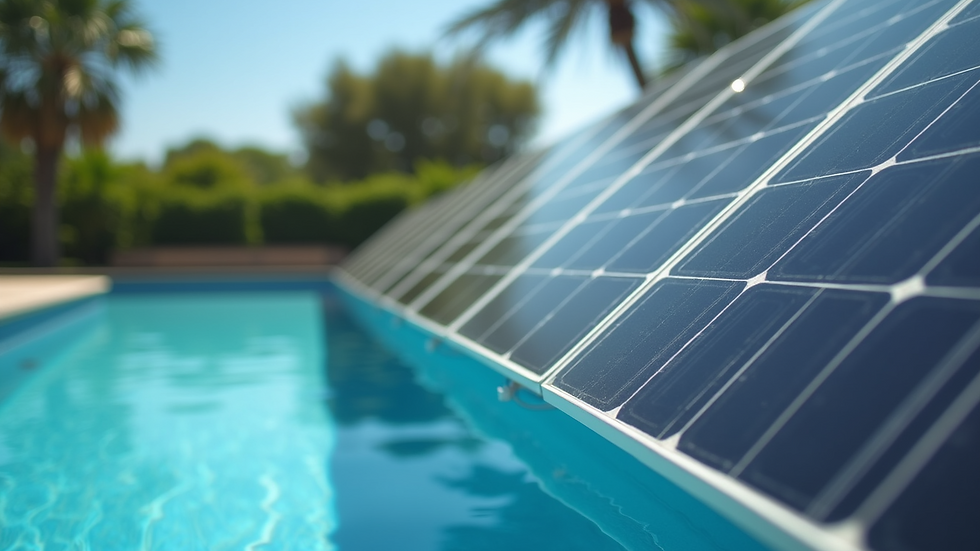Exploring Eco-Friendly Options for Pool Maintenance
- Brian Richardson
- Sep 29
- 4 min read
Maintaining a swimming pool can be a rewarding experience, but it often comes with environmental concerns. Traditional pool care relies heavily on chemicals like chlorine, which can be harsh on the environment and your health. Fortunately, there are many eco-friendly options available today that help keep pools clean and safe without compromising the planet. This guide explores practical, sustainable ways to maintain your pool while reducing your ecological footprint.
Understanding Eco-Friendly Pools and Their Benefits
Eco-friendly pools are designed or maintained with sustainability in mind. This means using methods and products that minimize environmental impact, conserve water, and reduce chemical use. The benefits of eco-friendly pools include:
Reduced chemical exposure: Less reliance on harsh chemicals means safer water for swimmers and less pollution.
Lower water consumption: Efficient filtration and maintenance reduce the need for frequent refilling.
Energy savings: Using energy-efficient pumps and solar heating cuts down on electricity use.
Improved ecosystem health: Avoiding harmful chemicals protects local wildlife and groundwater.
Some common features of eco-friendly pools include natural filtration systems, energy-efficient equipment, and the use of alternative sanitizers. These pools not only promote a healthier swimming environment but also contribute to long-term cost savings.

Practical Tips for Maintaining Eco-Friendly Pools
Maintaining an eco-friendly pool requires a combination of smart equipment choices and sustainable practices. Here are some actionable tips to help you keep your pool clean and eco-friendly:
1. Use Energy-Efficient Pool Pumps and Filters
Traditional pool pumps can consume a lot of electricity. Switching to a variable-speed or energy-efficient pump can reduce energy use by up to 90%. Pair this with a high-quality filter that requires less frequent cleaning to save water and energy.
2. Opt for Solar Pool Heating
Instead of gas or electric heaters, solar pool heaters use the sun’s energy to warm your pool. This method is cost-effective and reduces carbon emissions.
3. Cover Your Pool When Not in Use
Using a pool cover helps prevent evaporation, keeping water levels stable and reducing the need for refills. It also keeps debris out, reducing cleaning time and chemical use.
4. Maintain Proper Water Chemistry
Regularly test your pool water to keep pH and alkalinity balanced. Balanced water reduces the need for excessive chemicals and protects pool surfaces.
5. Use Natural Cleaning Methods
Manual cleaning with brushes and nets reduces reliance on chemical cleaners. Additionally, consider installing a robotic pool cleaner that uses less energy and water.

Can a Pool Stay Clean Without so much Chlorine?
Many pool owners wonder if it’s possible to maintain a clean and safe pool while using less chlorine. The answer is yes, but it requires alternative methods and consistent care.
Alternative Sanitizers
There are several chlorine alternatives that effectively sanitize pool water without the harsh effects of chlorine. These include:
Saltwater systems: These generate chlorine naturally through salt electrolysis, resulting in gentler water.
Ozone generators: Ozone is a powerful oxidizer that kills bacteria and viruses without leaving chemical residues.
UV systems: Ultraviolet light disinfects water by destroying microorganisms.
Mineral purifiers: These use silver and copper ions to inhibit algae and bacteria growth.
Each of these options has pros and cons, but they all reduce the need for traditional chlorine. For those interested in exploring these options, chlorine alternatives pool solutions offer a variety of eco-friendly sanitizing technologies.
Consistent Maintenance Is Key
Even with alternative sanitizers, pools require regular cleaning, water testing, and filtration to stay safe and clear, and it’s especially important to monitor water quality closely to prevent algae and bacteria buildup.

Eco-Friendly Pool Landscaping and Water Conservation
The area surrounding your pool can also contribute to its eco-friendliness. Thoughtful landscaping and water management can reduce environmental impact and enhance your pool experience.
Use Native Plants
Planting native, drought-resistant plants around your pool reduces water use and maintenance. These plants are adapted to local conditions and require less fertilizer and pesticides.
Create Natural Shade
Trees and shrubs can provide shade, reducing water evaporation and cooling the pool area naturally. This can also lower the need for pool heating.
Choose Permeable Surfaces
Using permeable materials for pool decks and walkways allows rainwater to soak into the ground, reducing runoff and erosion.
Embracing Technology for Sustainable Pool Care
Modern technology offers many tools to help pool owners maintain eco-friendly pools with less effort and waste.
Smart Pool Monitors
These devices continuously measure water quality parameters like pH, chlorine levels, and temperature. They send alerts to your phone, helping you adjust chemicals only when necessary.
Automated Chemical Feeders
Automated feeders dispense sanitizers and pH balancers in precise amounts, reducing chemical waste and maintaining balanced water.
Energy-Efficient Lighting
Switching to LED pool lights reduces electricity consumption and lasts longer than traditional bulbs.
Solar-Powered Pool Accessories
From pumps to cleaners, solar-powered devices harness renewable energy to keep your pool running sustainably.
By adopting these eco-friendly pool maintenance strategies, you can enjoy a clean, safe swimming environment while protecting the planet. Whether you choose natural landscaping, alternative sanitizers, or energy-efficient technology, every step counts toward a greener pool experience. Embrace these options to make your pool a refreshing oasis that’s kind to the environment.



